- Your Government
-
Our Community
-
- About St. Helens History of St. HelensState of the CityCourthouse Dock Camera
- Local Events City Calendar Citizens Day in the ParkRecreation Activities Discover Columbia County Sand Island CampingKeep It Local CC
- Community Resources City Newsletter City Social Media Emergency Services New Resident InformationProtecting Our Environment
-
-
Business & Development
-
- Local Business Directory Get a Business License City Bids & RFPs Broadband Study
- Business in St. Helens St. Helens Advantages Directions & Transportation Incentives & Financing Resources for Businesses Business Guide Columbia Economic Team Chamber of Commerce
- Current City Projects Waterfront Redevelopment Public Safety Facility Strategic Work Plan
-
-
How Do I?
-
- Apply for a Job Apply for a Committee Find A Park Find COVID Info Find Forms Follow St. Helens - Facebook Follow St. Helens - Twitter Follow St. Helens - YouTube
- Get a Police Report Get a Business License Get a Library Card Get a Building Permit Newsletter Signup Past Public Meetings Pay My Water Bill
- Public Records Request Report a Nuisance Register for Rec Activity Reserve a Park Sign Up for the 911 Alerts Universal Fee Schedule
-
Is there Lead in our Drinking water?
Lead and Drinking Water
When we hear about the possibility of Lead in our drinking water, what mental picture first comes to your mind? A rushing mountain stream flowing over rocks and creating waterfalls and whitewater rapids, perhaps a beautiful lake or river, or perhaps those ice cold bottles of water in your refrigerator? No, we immediately call to mind a drinking 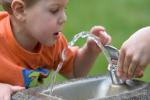 water faucet perhaps in our own home, the kitchen or bathroom faucet? The next mental picture we see are the faucets and drinking fountains in our offices, restaurants and schools.
water faucet perhaps in our own home, the kitchen or bathroom faucet? The next mental picture we see are the faucets and drinking fountains in our offices, restaurants and schools.
Yes, lead is a hazardous metal and a cumulative poison that we should take time to consider as to 1) where does Lead come from, 2) how does Lead get into our tap water 3) what can I do to protect myself and my family? 4) Is there Lead in St. Helens drinking water? (The answer to #4 is NO!) 5) what are its health effects?
This article is designed to help provide you with the answers to these questions and assist you in making “informed decisions” and take affirmative action to protect ourselves and our families at home and when out in public or even traveling.
Where does Lead come from? A short history of lead
The word plumbing is based on the Latin word for "Lead", which is plumbum, and our use of "Pb" as the chemical symbol for Lead comes from the ancient Romans.
 The ancient Romans used lead to make water pipes that provided indoor plumbing, and the decline of the Roman Empire has been blamed, in part, on lead being present in their water. Now, let’s fast forward two thousand years to the new world, where many cities were installing lead water supply pipes up until about 1955! (There are still some places around the United States that lead pipes are still in use today!) Installing Lead pipes was done despite the fact that health issues with lead had been known for centuries. Even in ancient Roman times, it was understood that water delivered in clay pipes was healthier than water supplied by lead pipes. You cannot see, taste, or smell lead in drinking water.
The ancient Romans used lead to make water pipes that provided indoor plumbing, and the decline of the Roman Empire has been blamed, in part, on lead being present in their water. Now, let’s fast forward two thousand years to the new world, where many cities were installing lead water supply pipes up until about 1955! (There are still some places around the United States that lead pipes are still in use today!) Installing Lead pipes was done despite the fact that health issues with lead had been known for centuries. Even in ancient Roman times, it was understood that water delivered in clay pipes was healthier than water supplied by lead pipes. You cannot see, taste, or smell lead in drinking water.
What is Lead?
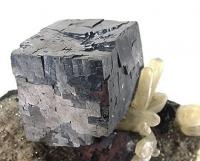 Lead is a soft, malleable and corrosion resistant material that is smelted from a
Lead is a soft, malleable and corrosion resistant material that is smelted from a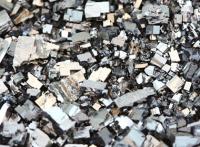 mineral ore called Galena. Galena is very easy to smelt to extract the lead and even silver. The rocks that contain Galena are placed in a fire and the lead can be collected from below the ashes after the fire burns out. The most common way today to extract the lead is obtained by roasting galena in hot air at 450ºF. People have taken advantage of this simple smelting and extraction method for thousands of years. Lead is probably the first metal to have been processed from an ore.
mineral ore called Galena. Galena is very easy to smelt to extract the lead and even silver. The rocks that contain Galena are placed in a fire and the lead can be collected from below the ashes after the fire burns out. The most common way today to extract the lead is obtained by roasting galena in hot air at 450ºF. People have taken advantage of this simple smelting and extraction method for thousands of years. Lead is probably the first metal to have been processed from an ore.
How does Lead get into our tap water?
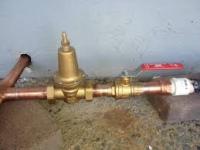 The most common way for lead to get into your tap water is from your household plumbing. Lead can leach, from the solder used in household copper plumbing, metal faucets and fixtures that are made from brass. (Brass is an alloy of copper and zinc that often contains lead impurities, this includes chrome-plated brass fixtures.) Brass fixtures can even leach lead in homes with plastic water lines. Older homes built prior to the mid-1950’s are more likely to have actual lead pipes and service lines. Homes built between the mid-1950s and 1989 are not likely to have lead pipes or service lines, however, there may be lead in some of the brass fixtures or the solder that was used to put together the copper pipes of the plumbing throughout your home. (The older solder that was used in constructing copper piping in homes was an alloy of tin with lead, antimony, or silver.) Current measures taken during the last two decades have greatly reduced exposures to lead in tap water. These measures include actions taken under the requirements of the 1986 and 1996 amendments to the Safe Drinking Water Act (http://www.epa.gov/sdwa) and the U.S. Environmental Protection Agency’s (EPA’s) Lead and Copper Rule (http://www.epa.gov/dwreginfo/lead-and-copper-rule).
The most common way for lead to get into your tap water is from your household plumbing. Lead can leach, from the solder used in household copper plumbing, metal faucets and fixtures that are made from brass. (Brass is an alloy of copper and zinc that often contains lead impurities, this includes chrome-plated brass fixtures.) Brass fixtures can even leach lead in homes with plastic water lines. Older homes built prior to the mid-1950’s are more likely to have actual lead pipes and service lines. Homes built between the mid-1950s and 1989 are not likely to have lead pipes or service lines, however, there may be lead in some of the brass fixtures or the solder that was used to put together the copper pipes of the plumbing throughout your home. (The older solder that was used in constructing copper piping in homes was an alloy of tin with lead, antimony, or silver.) Current measures taken during the last two decades have greatly reduced exposures to lead in tap water. These measures include actions taken under the requirements of the 1986 and 1996 amendments to the Safe Drinking Water Act (http://www.epa.gov/sdwa) and the U.S. Environmental Protection Agency’s (EPA’s) Lead and Copper Rule (http://www.epa.gov/dwreginfo/lead-and-copper-rule).
What can I do to protect myself and my family?
pH Water corrosivity is controlled primarily by the water’s acidity and calcium carbonate content. In general, acidic water that has a pH less than 7 and that is low in calcium carbonate is more corrosive than water that has a pH higher than 7 and that is high in calcium carbonate. St Helens water has a pH of 7.4 to 7.6 so this is not a problem for you to be concerned about.
Water temperature As water warms up, it becomes more aggressive and becomes “hungry” and begins dissolving materials it is in contact with and adds them into itself.
a) St. Helens water is 54º to 56ºF year round, however, the water in your household plumbing may sit idle for 6, 7 or 8 hours while you are at work, or overnight as you sleep and your idle water temperature may rise to 68º or 74º inside your household plumbing and fixtures.
b) In your office, besides all night, there might be a weekend in there, when no water has flowed through the buildings plumbing or fixtures for 2 or 3 days, the temperature may rise to 85º.
c) And with a school, we once again have overnight, and then spring break and summer break, where the water lines may be idle for weeks or even months.
Of what importance is knowing this information? Note: For every 17 degrees rise in temperature of water, the corrosive factor of the water doubles! This now sounds like we have a bigger problem, and just what do we do? Please take notice of the suggestions provided in the next subject line.
d) The standing (idle) time of the water in the plumbing system. Lead and copper concentrations in drinking water usually are the highest in the first draw of water out of the tap; they decrease as the water is run before taking your glass of water or filling the cooking pot with water. AWWA (American Water Works Association) suggests that the practice of running 30 seconds of water from your faucet before using the water for brushing your teeth or drinking. One might use that first draw to wash your hands or catching in a container and watering your indoor plants..
Suggestions for reducing lead in public and household plumbing.
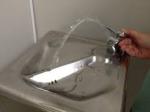 a) Drinking from a public, wall mounted, refrigerated, water fountain, turn on the fountain and listen and feel for the refrigerator/cooler to turn on inside the fountain. This signals you that the “warmer” and standing water has flowed through the copper coil in the refrigeration tubing and now fresh new water has entered the coil and the idle water has left the coil. This is when to take your drink from the fountain.
a) Drinking from a public, wall mounted, refrigerated, water fountain, turn on the fountain and listen and feel for the refrigerator/cooler to turn on inside the fountain. This signals you that the “warmer” and standing water has flowed through the copper coil in the refrigeration tubing and now fresh new water has entered the coil and the idle water has left the coil. This is when to take your drink from the fountain.
(b) The same is true with a public water fountain in a park, highway rest stop or a public 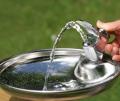 building. Turn on the water for up to a minute, feel the temperature of the water flowing from the faucet, and when it begins getting cooler, you have flushed the line of the older, warmer, sitting in the line, water and now take your drink or fill your water bottle etc.
building. Turn on the water for up to a minute, feel the temperature of the water flowing from the faucet, and when it begins getting cooler, you have flushed the line of the older, warmer, sitting in the line, water and now take your drink or fill your water bottle etc.
(c) In the office, when you arrive in the morning, turn on the faucet in the break room for 1 or 2 minutes, perhaps flush the toilets and get that weekend or overnight “idle” water out of the lines, and if there is a wall mounted drinking fountain, do the 30 second water flush.
d) How can schools reduce lead levels in drinking water ?
Things schools can do to reduce lead in drinking water.
1) Advise staff and students to run the water for a few seconds before drinking.
2) Remove or replace fixtures that leach lead.
3) Flush the piping system in the building.
4) Provide bottled water.
5) Repair the plumbing system.
6) Use only the cold-water tap for drinking, preparing juice or cooking.
7) Install water treatment devices.
How can schools test for lead in drinking water?
Testing for lead in schools (PDF) can be complex, especially the first time. It requires researching your school design, training staff to take samples correctly, and clear communication before and after sampling is completed. The Environmental Protection Agency (EPA) developed the 3Ts for Reducing Lead in Drinking Water in Schools: Revised Technical Guidance (PDF), designed to help school officials test for lead.
https://www.epa.gov/sites/production/files/2015-09/documents/toolkit_lea...
The 3T’s are:
Training school officials about the sources and health effects of lead, identifying potential areas where elevated lead may occur, and developing a testing plan.
Testing for lead and taking proper corrective action.
Telling students, parents, staff and the community about the plan to test, the results, and any remediation actions.
If you want to test your school’s water, we recommend you follow this guidance as you develop your testing plan.
What are the health affects of Lead?
https://www.epa.gov/ground-water-and-drinking-water/basic-information-ab...

Do you have any questions or comments, please feel free to send us an e mail or call
503-397-1311
